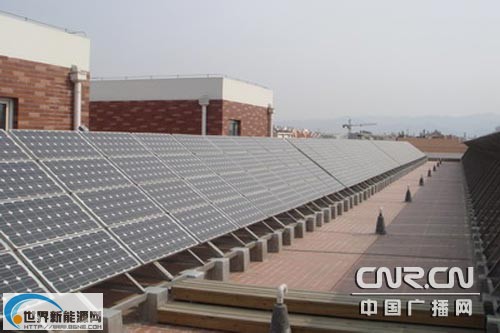The green way often doesn't come easily. China is trying hard to promote solar panels, but the process of transformation looks even harder than producing for the entire world.
 |
|
Solar photovoltaic panels |
Though China is the world's largest solar panel producer, it is still lagging when it comes to solar electricity usage.
While the government has taken steps to promote green energy by offering subsidies for solar photovoltaic installations, the response has not been that encouraging despite the huge financial incentives.
The Ministry of Finance, together with the Ministry of Housing and Urban-Rural Development, issued a statement on March 26 that the central government would offer a subsidy of 20,000 yuan per output kilowatt this year for solar power projects of 50 kilowatts and above capacity.
Priority would be given to companies developing, connecting and installing the photovoltaic applications, according to the statement.
It would take nearly 300 solar panels to cover an area of 400 sq m, if the 170-watt photovoltaic panels (such as those proposed by Suntech, a leading solar energy company in eastern China) are used to build a 50-KW rooftop solar project.
The purchase and installation of photovoltaic panels would cost around 10,000 yuan. So once such a project is completed, as promised by the central government agencies, the project owner can get roughly 20,000 yuan as incentives, about enough to cover the total investment.
According to a more conservative way of accounting, as on the Ministry of Finance website, the total purchase and installation cost would be around 40,000 yuan.
In either case, the owner of a solar power project can reap considerable savings than from a coal-fired thermal power project, whose building cost would range from 7,000 to 8,000 yuan per KW in capacity. In 2008, China's output of solar panels and cells represented 2,000 MW in capacity, but only 2 percent of these were used to meet the domestic demand, while the balance was exported.
However, many of these manufacturers have started to explore domestic markets now, as revenue from the major export markets has declined due to the global economic slowdown, according to the 21st Century Business Herald.
The government's incentive package is also designed to help Chinese manufacturers cope with the temporary slump in the overseas market by tapping domestic demand, said He Zuoxiu, a scientist involved in the Chinese solar energy program from the Chinese Academy of Sciences.
He, however, expressed disappointment that "not too many" project applications were filed, when the deadline for first batch approvals expired on May 15.
The incentives have also not generated much public discussion and people in many provinces are not even aware of such incentives, He said.
The scientist said that so far, only one municipal-level project, Yangzhou in East China's Jiangsu province, has applied for the scheme.
"The Yangzhou government has drawn up a plan to generate one-fifth of the city's electricity demand from solar panels," He said.
Jiangsu is the province that is also planning to turn to solar power in a big way for its electricity needs.
The Chinese-language China Business News quoted unnamed sources as saying that the provincial government is coming up with an ambitious solar industry stimulus plan in May, aimed at raising Jiangsu's rooftop capacity from 10 MW in 2009, to 40 MW in 2010, and to 180 MW in 2011. The province is also preparing the special fund for the same, the report said.
Industry observers said China is not ready to extend subsidies directly to individual solar power users as they still cannot sell the excess electricity that they have generated to the national grid.
However, China's potential is great. It owns a total of 10 billion sq m of rooftops and that, if entirely utilized, would allow for an installed capacity of 500 MW, according to He. In comparison, the nation's total installed power generating capacity is about 800 MW, and more than 70 percent of this is derived from coal.
"I don't expect China to immediately make use of all its rooftops," He said. "But if it can make use of one-fifth of the capacity, it could still have an installed capacity of 100 MW of solar energy, tantamount to five Three Gorges hydropower stations," he said.
(China Daily May 22, 2009)